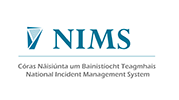
National Incident Management System (NIMS)
The HSE is the ‘owner’ of the NIMS healthcare data with respect of patient safety/service user incidents. The SCA is the joint controller of incident data and ‘owner’ of data with respect to patient safety related claims. The HSE in conjunction with the SCA jointly manage NIMS. Note: other incident and claim types are also captured, managed, and analysed on NIMS. There is also an aligned but separate governance with Tusla for service user’s incidents.
2003
To maintain and provide the national database of patient safety incident data that meets the needs of data users in the health and social care sector (including quality and patient safety clinical teams, management, policy makers, risk/health and safety managers, facilities staff, and researchers) whilst also supporting effective claims and risk management by the HSE and the SCA. Note comment above re: Tusla.
NIMS is used by all the public health and social care service and is provided to certain private hospitals as part of SafetNet. The areas covered include:
- all Hospital Groups, acute hospitals
- the CHO’s and Voluntary Community (S. 38’s) healthcare sectors
- National Ambulance Service
- HSE Corporate.
Note: TUSLA also
The database was implemented across the Health Care sector from 2004 with rollout completion in 2006.
National Incident Management System (NIMS) is the principal source of national data on incident activity for the Irish health and social care service. It has been designated as the primary system for end to end risk management of all incidents (capture, investigations and reporting) both by the DoH and the HSE. It is an end to end risk management web-based system and its purpose is as follows:
- Capture of incidents (including Serious Reportable Events); involving patients including dangerous occurrences and complaints
- Management of incident reviews
- Recording of review conclusions
- Recording of review recommendations
- Tracking recommendations to closure
- Multiple reporting and analytical tools which could be pointed at all captured data
- Facilitates reporting and analysis of patient safety incident data captured
- Facilitates reporting and analysis of review conclusions and contributory factors
- Facilitates reporting and analysis of key performance indicators (KPIs) as set out in the HSE Service Plan
- Facilitates the analysis of safety performance to inform risk initiatives.
Note: NIMS also captures incidents involving health care workers (HCW) and members of the public and property damage. It also is used to manage claims arising from all incident types.
Patient safety data collection used by HSE National Directorate Quality and Patient Safety,
Quality and Patient Safety Professionals, medical researchers, HC managers, Department of Health NPSO, medical professional bodies, HC organisations, SCA.Data from NIMS is also provided to and used by Government, public representatives and media.
Includes demographic details, locations, incident type, division, specialties, procedures/medications, injuries, outcomes, severity ratings, contributory factors, actions taken/planned and values e.g. birth rates, bed days, employee headcount etc.
Available to NIMS users via the systems ‘News and Announcements’ Page. This is available to registered and licensed users of NIMS.
There are currently no national level identifiers where it was included main address and location are the individual identifiers.
For incident data the following equity stratifiers and may be collected place of residence, occupation and gender. Note residence will apply to a smaller percentage of incidents as most incidents occur in a workplace or in a Health Care providers premises. For claims arising from incidents all investigation, medical, legal reports, actuarial reports, other expert reports etc may attach to the claim on the system may possibly include all the equity stratifiers however claims screen fields only require place of residence, occupation and gender.
NIMS is a confidential, highly secure web-based IT system that links hospitals and other health social care enterprises to a core database. Information is entered to the system locally either via paper based National Incident Report Forms (NIRF) or electronic point of entry reporting (ePoE) and subsequently reviewed. Data relating to the reviews conclusions and outcomes can then be input to the system.
Data is available to users depending on their role – hierarchical access model.
Anatomical Therapeutic Chemical Classification System (ATC) and aligned to the World Health Organisation (WHO) Conceptual Framework for the International Classification for Patient Safety.
Approximately 170,000 patient safety related records created annually.
Daily, Monthly, Quarterly, Annually and as per request.
Real time access to dashboards and reports is available to all users.
Each health and social care enterprise has access to its own data in order to identify emerging trends for risk management purposes, media requests and parliamentary questions. External requests can be forwarded to either NIMS@hse.ie or the SCA Data Services Team at stateclaims@ntma.ie
No.
Future development includes:
- work ongoing to implement HIQA report ‘Review of information management practices for the National Incident Management System (NIMS) within the HSE’ , May 2021 recommendations
- continued programme to convert method of incident capture from paper based to electronic using NIMS ePoE functionality
- addition of Risk Register module
- reconfiguration to allow for reporting as required by the Patient Safety Bill
- addition of Clinical Audit module.